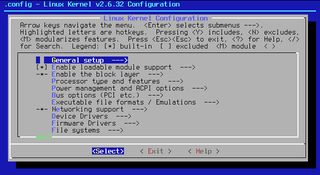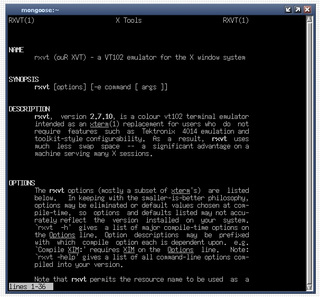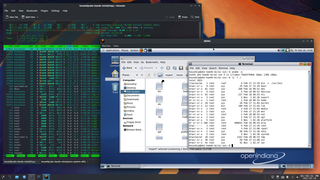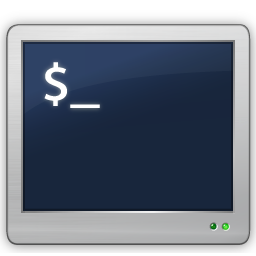
ncurses is a programming library providing an application programming interface (API) that allows the programmer to write text-based user interfaces (TUI) in a terminal-independent manner. It is a toolkit for developing "GUI-like" application software that runs under a terminal emulator. It also optimizes screen changes, in order to reduce the latency experienced when using remote shells.

A terminal emulator, or terminal application, is a computer program that emulates a video terminal within some other display architecture. Though typically synonymous with a shell or text terminal, the term terminal covers all remote terminals, including graphical interfaces. A terminal emulator inside a graphical user interface is often called a terminal window.

ANSI escape sequences are a standard for in-band signaling to control cursor location, color, font styling, and other options on video text terminals and terminal emulators. Certain sequences of bytes, most starting with an ASCII escape character and a bracket character, are embedded into text. The terminal interprets these sequences as commands, rather than text to display verbatim.

A computer terminal is an electronic or electromechanical hardware device that can be used for entering data into, and transcribing data from, a computer or a computing system. The teletype was an example of an early-day hard-copy terminal and predated the use of a computer screen by decades.

The VT220 is a computer terminal introduced by Digital Equipment Corporation (DEC) in November 1983. The VT240 added monochrome ReGIS vector graphics support to the base model, while the VT241 did the same in color. The 200 series replaced the successful VT100 series, providing more functionality in a much smaller unit with a much smaller and lighter keyboard. Like the VT100, the VT200 series implemented a large subset of ANSI X.364. Among its major upgrades was a number of international character sets, as well as the ability to define new character sets.

curses is a terminal control library for Unix-like systems, enabling the construction of text user interface (TUI) applications.

In computing, text-based user interfaces (TUI), is a retronym describing a type of user interface (UI) common as an early form of human–computer interaction, before the advent of modern conventional graphical user interfaces (GUIs). Like GUIs, they may use the entire screen area and accept mouse and other inputs. They may also use color and often structure the display using special graphical characters such as ┌ and ╣, referred to in Unicode as the "box drawing" set. The modern context of use is usually a terminal emulator.

Konsole is a free and open-source terminal emulator graphical application which is part of KDE Applications and ships with the KDE desktop environment. Konsole was originally written by Lars Doelle. It ls licensed under the GPL-2.0-or-later and the GNU Free Documentation License.

Rxvt is a terminal emulator for the X Window System, and in the form of a Cygwin port, for Windows.

In computing, xterm is the standard terminal emulator for the X Window System. It allows users to run programs which require a command-line interface.

QEMU is a free and open-source emulator. It emulates the machine's processor through dynamic binary translation and provides a set of different hardware and device models for the machine, enabling it to run a variety of guest operating systems. It can interoperate with Kernel-based Virtual Machine (KVM) to run virtual machines at near-native speed. QEMU can also do emulation for user-level processes, allowing applications compiled for one architecture to run on another.

Tera Term is an open-source, free, software implemented, terminal emulator (communications) program. It emulates different types of computer terminals, from DEC VT100 to DEC VT382. It supports telnet, SSH 1 & 2 and serial port connections. It also has a built-in macro scripting language and a few other useful plugins.

The mrxvt program is a terminal emulator for X Window System. It provides DEC VT102 compatible terminals.

In computing, an emulator is hardware or software that enables one computer system to behave like another computer system. An emulator typically enables the host system to run software or use peripheral devices designed for the guest system. Emulation refers to the ability of a computer program in an electronic device to emulate another program or device.

In software, the term feature has several definitions, which are often distinct from the more general definitions of the term. The Institute of Electrical and Electronics Engineers (IEEE) defines the term in IEEE 829 as a "distinguishing characteristic of a software item ".

ZOC is a popular computer-based terminal emulator and Telnet software client for the Microsoft Windows and Apple Macintosh macOS operating systems that supports telnet, modem, SSH 1 and 2, ISDN, serial, TAPI, Rlogin and other means of communication. Its terminal emulator supports Xterm emulation with full colors, meta-keys and local printing, VT102, VT220 and several types of ANSI as well as Wyse, TVI, TN3270, and Sun's CDE. It supports full keyboard remapping, scripting in REXX and other languages, and support for named pipes.

SecureCRT is a commercial SSH and Telnet client and terminal emulator by VanDyke Software. Originally a Windows product, VanDyke later added a Mac OS X version in 2010 with release v6.6 and a Linux version in 2011 with release v6.7.
A terminal multiplexer is a software application that can be used to multiplex several separate pseudoterminal-based login sessions inside a single terminal display, terminal emulator window, PC/workstation system console, or remote login session, or to detach and reattach sessions from a terminal. It is useful for dealing with multiple programs from a command line interface, and for separating programs from the session of the Unix shell that started the program, particularly so a remote process continues running even when the user is disconnected.

devpts is a virtual filesystem directory available in the Linux kernel since version 2.1.93. It is normally mounted at /dev/pts and contains solely devices files which represent slaves to the multiplexing master located at /dev/ptmx which in turn is used to implement terminal emulators.

PCem is an IBM PC emulator for Windows and Linux that specializes in running old operating systems and software that are designed for IBM PC compatibles. Originally developed as an IBM PC XT emulator, it later added support for other IBM PC compatible computers as well.

















